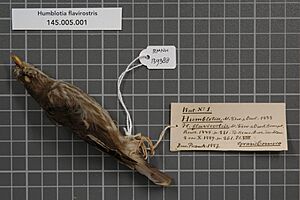Humblot's flycatcher facts for kids
Quick facts for kids Humblot's flycatcher |
|
|---|---|
 |
|
| Conservation status | |
| Scientific classification | |
| Genus: |
Humblotia
|
| Species: |
flavirostris
|
Humblot's flycatcher (scientific name: Humblotia flavirostris), also known as the Grand Comore flycatcher, is a small songbird. It belongs to a group of birds called Old World flycatchers. This special bird is the only species in its entire genus. Humblot's flycatcher lives only on the island of Grand Comoro in the Comoros. You can find it in the forests on the slopes of Mount Karthala. Its scientific name honors a French scientist named Léon Humblot.
What Does It Look Like?
This flycatcher has grey-brown feathers on its back. Its belly is pale with dark stripes. It has a dark head with lighter streaks. Its beak and feet are a bright yellow-orange color.
Humblot's flycatcher is about 14 centimeters (5.5 inches) long. That's about the length of a pen. It usually doesn't make much noise. But it does have a soft, trilling call.
This bird's feathers are very soft and fluffy. It also has special feathers on its head. These feathers are starting to form a small crest.
What Does It Eat and How Does It Live?
Humblot's flycatcher mostly eats insects. It catches them by flying quickly from a low branch. It often hunts from a perch in a tree or bush.
These birds sometimes feed in small groups. You might see two or three of them together. Not much is known about their breeding habits. Scientists have only found one nest so far. This nest was shaped like a cup and built high in a tree. It held at least two young birds.
Why Is It in Danger?
Humblot's flycatcher lives in a very small area. Its home is threatened by several things. Forests are being destroyed and damaged. This is called habitat destruction.
Also, new plants and animals are arriving. These are called introduced species. For example, the strawberry guava plant is spreading. It can take over areas where native plants grow. The common myna bird and rats are also a problem. They might raid the flycatcher's nests.
There are about 10,000 to 19,000 Humblot's flycatchers left. Their numbers are going down. Because of this, the International Union for Conservation of Nature says it is a vulnerable species. This means it could become endangered if we don't protect it.


